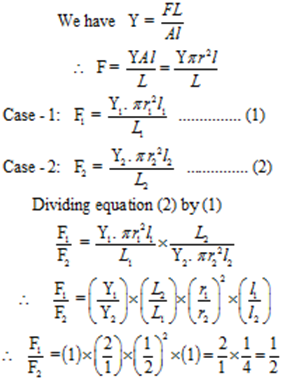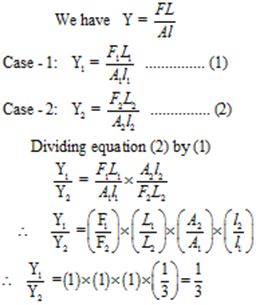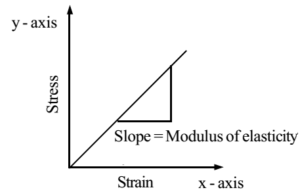Science > Physics > Elasticity > Stresses and Strains in Compound Wires
Problem – 1:
For two wires of the same material, both the radii and lengths are in the ratio 1:2. What should be the ratio of stretching forces on the wires if equal extensions are to be produced in the two?
Given: Ratio of radii = r1 / r2 = 1/2, Ratio of length = L1 / L2 = 1/2, Extension equal l1 = l2 hence l1 / l2 = 1, Material is same hence ratio of Young’s moduli Y1 / Y2 = 1,
To Find: Ratio of stretching force = F1 / F2 =?
Solution:

Ans: The ratio of stretching forces is 1:2.
Problem – 2:
Two wires of different material, but of the same cross-section and length are stretched by the same force. Find the ratio of Young’s moduli are of their material if the elongations produced in them are in the ratio 3:1.
Given: Same Cross-section, hence the ratio of area = A1 /A2 = 1, Lengths are same hence the ratio of length = L1 / L2 = 1, Same stretching force hence F1 / F2 = 1, Ratio of elongation l1 / l2 = 3:1,
To Find: Ratio of Young’s moduli = Y1 / Y2 =?
Solution:

Ans: The ratio of Young’s moduli is 1:3.
Problem – 3:
Two wires are of the same material. Wire 1 if four times longer than the wire 2 but wire 1 has a diameter double that of wire 2. Compare stresses and elongations produced in the wires when under the same load.
Given: Material is same hence ratio of Young’s moduli Y1 / Y2 = 1, Length L1 = 4 L2 hence L1 / L2 = 4, Diameter d1 = 2 d2 hence d1/d2 = 2, hence ratio of radii = r1/r2 = 2, Load is same F1 / F2 = 1
To Find: Ratio of stresses =? Ratio of elongations =?
Solution:
To find the ratio of stresses

To find ratio of elongations

Ans: The ratio of stresses is 1:4
The ratio of elongation is 1:1. Hence elongations are equal
Example – 4:
Two wires of the same material have lengths in the ratio 2:1 and diameters are in the ratio 2:1 Find the ratio of extensions produced in the wires when the stretching forces acting on them are in the ratio 2:1
Given: Material is same hence ratio of Young’s moduli Y1 / Y2 = 1, Ratio of lengths = 2: 1 i.e. L1 / L2 = 2, Ratio of diameters = 2:1 hence d1/d2 = 2, hence ratio of radii = r1/r2 = 2, Load is same F1 / F2 = 2:1
To Find: Ratio of extensions =?
Solution:

Ans: The ratio of extension is 1: 1.
Hence the extensions in two wires are equal
Problems Based on Compound wire:
Example – 5:
A brass wire (Y = 11 × 1010 N/m²) and a steel wire (22 × 1010 N/m²) of the same length and cross-section are joined end to end. The composite wire is hung from a rigid support and weight is suspended from the free end. Find the extension in each wire if the increase in the length of the composite wire is 0.279 cm.
Given: Young’s modulus for brass Yb = 11 × 1010 N/m², Young’s modulus for steel Ys = 22 × 1010 N/m², Lengths of wire are same i.e Lb / Ls = 1, Crosssection are same i.e. Ab/As = 1, Load is same Fb / Fs = 1, Total extension in composite wire = lb + ls = 0.279 cm
To Find: extension in brass wire and steel wire =?
Solution:

lb = 2 ls
lb + ls = 0.279 cm
∴ 2 ls + ls = 0.279 cm
∴ 3 ls = 0.279 cm
∴ ls = 0.093 cm
Now lb = 2 ls = 2 × 0.093 = 0.186 cm
Ans: Extension in brass wire = 0.186 cm and
extension in steel wire = 0.o93 cm
Example – 6:
A uniform brass wire (Y = 10 × 1010 N/m²) and a uniform steel wire (Y = 20 × 1010 N/m²) each of length 3.14 m and diameter 2 × 10-3 m are joined end to end to form a composite wire is hung from a rigid support and a load suspended from the free end. If the increase in the length of the composite wire is 6 × 10-3 m, find the increase in the length of each wire.
Given: Young’s modulus for brass Yb = 10 × 1010 N/m², Young’s modulus for steel Ys = 20 × 1010 N/m², Lengths of wire are same each 3.14 m i.e Lb / Ls = 1, Diameter is same each 2 × 10-3 m, Hence cross-section are same i.e. Ab/As = 1, Load is same Fb / Fs = 1, Total extension in composite wire = lb + ls = 6 × 10-3 m
To Find: extension in brass wire and steel wire =?
Solution:

lb = 2 ls
lb + ls = 6 × 10-3 m = 6 mm
∴ 2 ls + ls = 6 mm
∴ 3 ls = 6 mm
∴ ls = 2 mm
Now lb = 2 ls = 2 × 2 = 4 mm
Ans: Extension in brass wire = 4 mm and
extension in steel wire = 2 mm
Example – 7:
A light rod 1 m long is suspended horizontally by two wires of the same length and of the same cross-section but of different materials. The Young’s modulus of material of one wire is 30 x 1010N/m2 and that of the other is 20 x 1010N/m2. At what point should a weight W be hung from the rod so that it still remains horizontal? Ans: (0.4 m from the first wire)
Example – 8:
A weightless rod 105 cm long is suspended horizontally by two wires P and Q of equal length. The crosssection of P is 1 mm2 and that of Q is 2 mm2. From what point on the rod should a weight be suspended in order to produce equal strains in P and Q? Yp= 2 x 1011N/m2; YQ = 1011 N/m2. Ans: (Midpoint)
Example – 9:
A brass wire of length 5 m and of sectional area 1 mm2 is hung from a rigid support with a brass weight of volume 1000 cc hanging from the other end. Find the decrease in length of the wire when the brass weight is completely immersed in water. Y = 1011N/m2. Take g = 10 m/s2. Density of brass = 8400 kg/m3 and of water = 1000 kg/m3. Ans: (0.5 mm)
Previous Topic: Problems on Poisson’s Ratio
Next Topic: Behaviour of Wire of Ductile Material Under Increasing Load

One reply on “Stresses and Strains in Compound Wires”
thank you so much your notes really helped me a lot